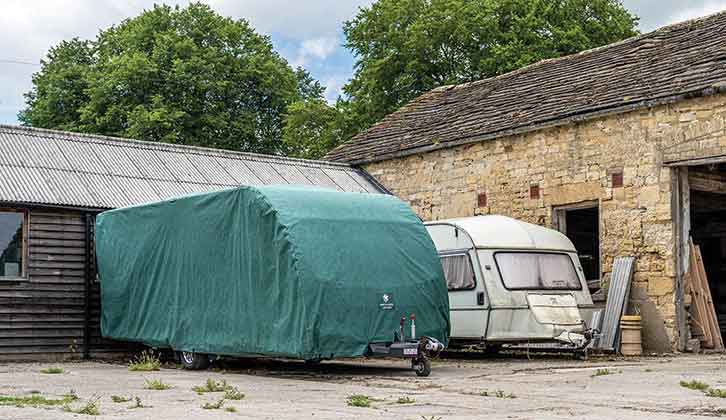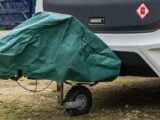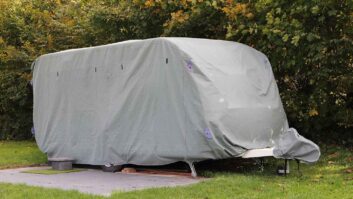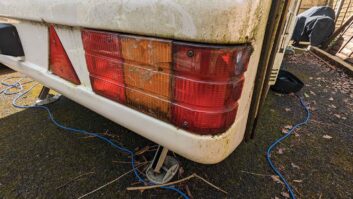A maintained caravan can provide a wonderful base for making many happy memories. One important part of keeping it looking its best will be protecting it during the offseason – that’s where covers come in.
The best caravan cover helps you shield your van from external factors such as UV rays and tree sap when you’re not using it. However, there are a variety of options on the market, presenting plenty of things to think about – should you go for a bespoke cover, for instance? What are the merits of the different types?
Here, I’m going to explain why caravan covers are a good idea, take a look at the different types, and more.
Practical Caravan is supported by its audience. When you purchase through links on our site, we may earn an affiliate commission. Learn more.
Why your caravan needs a cover
Most caravanners are unlikely to use their vans for more than half the year, meaning there will be long periods of time where a tourer is sitting idle. Leave even the best caravan stationary for this long and you may be surprised by the speed with which parts can start to deteriorate, from the corroding of metal components to the discolouration of the finish.
It’s not just the weather that plays a part here – UV rays can also damage our vans, resulting in chalking, flaking and cracking.
This is where a cover comes in, shielding our tourers from these harmful external factors, while also making the process of cleaning a caravan easier by protecting from tree sap, bird droppings and similar airborne factors. For example, without a towing cover, particulate-filled diesel fumes get caught in the vortices behind the tow car and become ingrained in the surface of the caravan’s front panel. This is damaging and discolouring.

Maintaining a van can also help you keep its value up, something which can be very handy should you decide to upgrade or downsize.
Lastly, a cover can also act as a good bit of caravan security, potentially offering enough of a visual deterrent to make thieves move on. In short, it’s easy to see why these are such an essential accessory.
What makes a good caravan cover?
Waterproofing
You’ll most likely come across the phrase ‘hydrostatic head’ when researching covers – this is essentially the scientific gauge of a material’s waterproofing. Picture a column of water on a piece of material – the height in millimetres (prior to water seeping through) will be a measure of just how waterproof it is.
The amount of waterproofing that brands say is required varies – for instance, Specialised Covers opts for a hydrostatic head of 2500mm, while Protec says 1000mm is sufficient.
It’s worth noting that while a large area of fabric may be waterproof, the process of stitching two panels together will inevitably lead to weak spots along the seams. As a result, a hallmark of the better options on the market will be minimal seaming. This is done for two reasons – firstly, to increase its overall waterproofing and secondly, to lower the prospect of weak seams ripping.
A breathable membrane layer
Another important factor to look out for will be whether the cover has a breathable membrane layer or not – this is essential as it allows vapours to escape through the fabric. Otherwise, caravan water ingress could occur underneath the cover, three words caravanners never want to think about.
A necessary component here will be heat – without this, moisture can’t vaporise. This isn’t a problem in the warmer months and even during the winter, a cover could absorb the required heat for evaporation to occur on a sunny day.
One thing to note – breathability and waterproofing are something of a balancing act – as one increases, the other decreases.
A soft inner surface
The finish on our tourers can lose their shine if they have a loose-fitting cover rubbing against them in the breeze. This is why a soft inner surface is another important trait of a good cover.

Strength and durability
Tensile strength, tear resistance plus elongation are three things you’re going to want your tourer’s cover to have. Pick a cover with these and you’re likely to find it will last you for years.
Custom fits
Unsurprisingly, a bespoke caravan cover is going to offer a better fit in comparison to a universal one, and typically be easier to put on too. However, if you don’t have the budget for a custom option, I’d advise taking your time to choose the universal fit that will best suit your tourer.
Factor in your equipment
Many caravanners have equipment such as a satellite dish or solar panel fitted. If this applies to you, be sure to consider it by choosing a custom cover.

Airflow
This is another balancing act. After all, a cover which flaps around wildly is the last thing you’ll want – however, one which allows a bit of airflow around the van can play a part in helping the evaporating process take place.
Will you need to access your van?
Are you likely to want to go in and out of your van while you’re storing it? If so, a cover with a quick-release door flap is well worth opting for – it will mean you can get in and out with ease. When you’re entering your tourer, these will be kept in place with hook-and-loop tape or zips.
The different types of caravan cover
Full covers
Full covers wrap the entire caravan in a protective embrace that keeps precipitation, grime and bird droppings at bay. Ideally you want one that has at least two straps, to keep the cover in place and stop it flapping about in the wind, which can cause abrasion damage with some covers.
These straps go all the way under the van, or around the corner steadies, clip together, then pull tight, to tension the cover material over the caravan.

The entire exterior of the tourer is often protected by a full cover, although some designs require a separate A-frame cover, to shield the jockey wheel, handbrake, ATC system and hitch head. I’d say this is an essential addition if you’re going to be storing a caravan long-term.
If you decide to order a full cover for your tourer, you’ll also need to consider whether you want door access. I believe this is vital, because I wouldn’t want to have to unstrap and partially remove the caravan cover every time I wanted to nip inside to check on or retrieve something.
Roof covers
Another option is a roof cover, and again, there are plenty of these to choose from.

For example, you could buy a Maypole 9264 Caravan Top Cover, which fit vans 19-21ft in length. This type of cover simply straps down and protects the roof of the caravan, shielding it from the worst that the elements, birds or trees might do, although this model is only described as water-resistant.
Specialised Covers offers a relatively new cover concept, with the protective material covering the front panel, roof and back panel. The cover slides into the awning rail on either side for secure fixing and attaches to the steadies at each corner. It doesn’t cover the A-frame, and is not suitable for towing – the material is not of the correct spec and there are no allowances in the design for your caravan’s driving lights. That said, manoeuvring your van around a storage site should not cause any problems.
This design is ideal if you need to gain entry to your tourer from time to time when it’s in long-term storage, because it will be easy to access and well-lit inside. Basic maintenance will also be easier, as will checking and charging your caravan leisure battery.
Towing covers
These partial covers will protect the front panels and windows of your van when it’s being towed. They are often padded for extra protection against stone chips, which can cause permanent damage by peppering the area behind the tow car’s rear wheels.

As always, you get what you pay for, and the best towing covers have zippable panels. This means that, if you have a short stopover when touring, you don’t need to remove the entire jacket just for that night: you can simply unzip the top panel to reveal the caravan’s front window.
Preparing to fit a cover
The first step is always going to be giving the exterior of your van a proper clean, taking care to get rid of the grime that can build up over a season of touring. I’d advise taking the time to use the best caravan polish as well – this helps to maintain the finish and also adds more protection.
Use some silicone spray or even olive oil on the window seals to help prevent cracking.
Give the tyres some attention too. I like to use Meguiar’s Endurance Tire Gel. Then I oil and grease the various moving parts, such as the corner steadies, the handbrake (see our guide to caravan brakes for more on this), the jockey wheel and so on. Once this is all done (I’d recommend giving yourself a day), your tourer will be ready to go when the new season comes around.
Where to order a cover
These are some of the major brands in the industry.
Maypole
Maypole is a major caravan accessory brand, offering a good selection of universal covers for budget-conscious caravanners. It makes caravan hitch, roof and full covers.
Its products are available in a range of sizes, with adjustable straps and hooks to provide a secure fit.
Maypole’s product literature does suggest that its covers shouldn’t be used in “exposed windy areas”. This is arguably true of any universal cover, as the tightness of the fit is unlikely to match a custom-made one.
Protec
Protec covers are designed to provide maximum protection for your caravan. Its covers are manufactured using the firm’s own Protex 003 triple-laminated material, which is strong, durable and waterproof, yet breathable.
In addition, the material provides excellent UV protection.
Protec says it has had its Protex 003 material independently tested against Specialised Covers’ Torrent fabric.
Results showed that Torrent was about five times more waterproof than Protex 003, but Protec’s fabric was 3.5 times more breathable.
Protec says that its fabric is more than waterproof enough for the very worst British weather, and it doesn’t need to be more waterproof, which would come at the expense of reduced levels of breathability. Note that the brand doesn’t make roof covers.
Royal Leisure
The Royal brand makes a wide range of caravanning accessories, including cost-effective universal-fit covers.
Its 19-21ft caravan cover is made of heavy-duty, three-layer, non-woven polypropylene. The weather-resistant material protects against the elements and damaging UV rays.
The cover’s elasticated, stitched hem provides universal fit, while its three zips provide easy access to your tourer.
The cover comes in a carry bag for storage and transportation, and is available in grey and green.
Specialised Covers
Specialised Covers is a premium manufacturer, which also supplies covers to luxury car manufacturers (from Bentley to Bugatti), F1 teams and even landspeed-record rocket cars!
It has been making tailored covers for more than 40 years now, and manufactures all three styles of cover, at a range of price points.
The firm is ISO 9001 compliant and has developed its own bespoke cover fabric, which combines waterproofing, breathability, strength and light weight. It prides itself on its ability to produce any custom-fit cover at its design and manufacturing base in Yorkshire.
The final word on whether caravan covers are any good
It’s easy to see the numerous benefits that this caravan essential offers. With a cover, you can keep your tourer looking its best, not only letting you tour with pride in your van but also helping you get a better price if you opt to sell it on at any point.
I’d recommend picking the best option within your budget – at the minimum, prioritise one with a soft lining, breathability and waterproofing.
Find out more about another useful van accessory, caravan trackers – these can be a very useful security gadget too, helping you to keep your van safe and secure.
If you’ve enjoyed reading this article, why not get the latest news, reviews and features delivered direct to your door or inbox every month. Take advantage of our brilliant Practical Caravan magazine SUBSCRIBERS’ OFFER and SIGN UP TO OUR NEWSLETTER for regular weekly updates on all things caravan related.

























